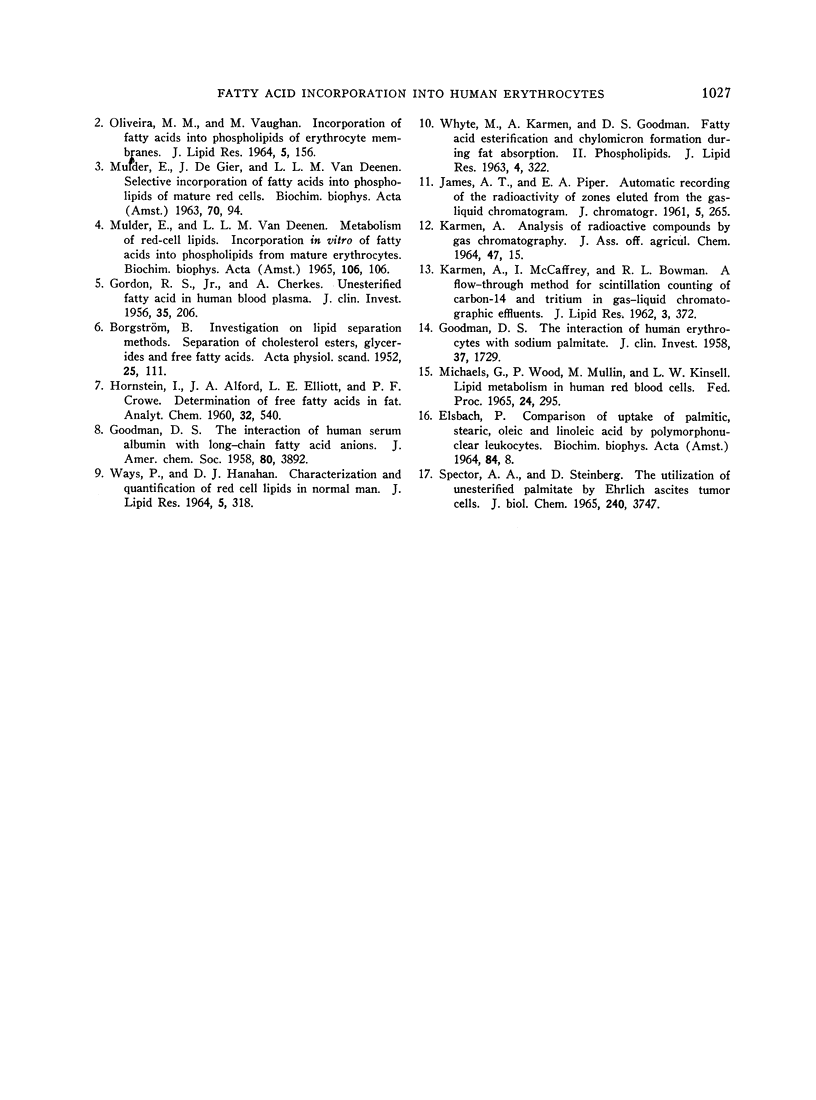Abstract
When human erythrocytes were incubated in vitro with 14C-labeled free fatty acids bound to serum albumin, labeled fatty acids were incorporated into erythrocyte triglycerides and phospholipids. The first step in this reaction was the transfer of free fatty acids from the albumin to the cells. This transfer was rapid and reversible. The acids were distributed between albumin and cells according to the relative quantities of albumin and cells present. Each acid had a different distribution coefficient. At equilibrium, relatively larger fractions of the stearic and palmitic acids and smaller fractions of the oleic and linoleic were associated with the cells. All these fatty acids were then slowly incorporated into phospholipids and triglycerides. The rate of incorporation of each was a function of its concentration in the cells, but larger fractions of the oleic and linoleic were incorporated than of the stearic, palmitic, myristic, or lauric. The two processes of transfer and incorporation thus had almost opposite selectivities for the different fatty acids. As a result, the fatty acids incorporated into triglycerides and phospholipids resembled in composition the fatty acids on the albumin except for moderately less stearic acid.
Full text
PDF










Selected References
These references are in PubMed. This may not be the complete list of references from this article.
- ELSBACH P. COMPARISON OF UPTAKE OF PALMITIC, STEARIC, OLEIC AND LINOLEIC ACID BY POLYMORPHONUCLEAR LEUKOCYTES. Biochim Biophys Acta. 1964 Feb 24;84:8–17. doi: 10.1016/0926-6542(64)90095-2. [DOI] [PubMed] [Google Scholar]
- FARQUHAR J. W., AHRENS E. H., Jr Effects of dietary fats on human erythrocyte fatty acid patterns. J Clin Invest. 1963 May;42:675–685. doi: 10.1172/JCI104759. [DOI] [PMC free article] [PubMed] [Google Scholar]
- GOODMAN D. S. The interaction of human erythrocytes with sodium palmitate. J Clin Invest. 1958 Dec;37(12):1729–1735. doi: 10.1172/JCI103765. [DOI] [PMC free article] [PubMed] [Google Scholar]
- GORDON R. S., Jr, CHERKES A. Unesterified fatty acid in human blood plasma. J Clin Invest. 1956 Feb;35(2):206–212. doi: 10.1172/JCI103265. [DOI] [PMC free article] [PubMed] [Google Scholar]
- Mulder E., van Deenen L. L. Metabolism of red-cell lipids. I. Incorporation in vitro of fatty acids into phospholipids from mature erythrocytes. Biochim Biophys Acta. 1965 Jul 7;106(1):106–117. doi: 10.1016/0005-2760(65)90099-8. [DOI] [PubMed] [Google Scholar]
- OLIVEIRA M. M., VAUGHAN M. INCORPORATION OF FATTY ACIDS INTO PHOSPHOLIPIDS OF ERYTHROCYTE MEMBRANES. J Lipid Res. 1964 Apr;5:156–162. [PubMed] [Google Scholar]
- Spector A. A., Steinberg D. The utilization of unesterified palmitate by Ehrlich ascites tumor cells. J Biol Chem. 1965 Oct;240(10):3747–3753. [PubMed] [Google Scholar]
- WHYTE M., KARMEN A., GOODMAN D. S. FATTY ACID ESTERIFICATION AND CHYLOMICRON FORMATION DURING FAT ABSORPTION. 2. PHOSPHOLIPIDS. J Lipid Res. 1963 Jul;4:322–329. [PubMed] [Google Scholar]
- Ways P., Hanahan D. J. Characterization and quantification of red cell lipids in normal man. J Lipid Res. 1964 Jul;5(3):318–328. [PubMed] [Google Scholar]


